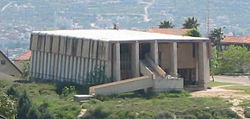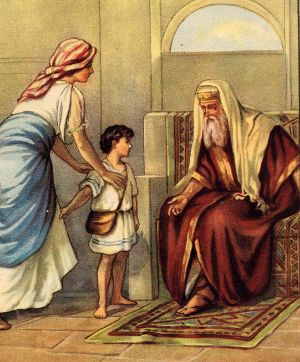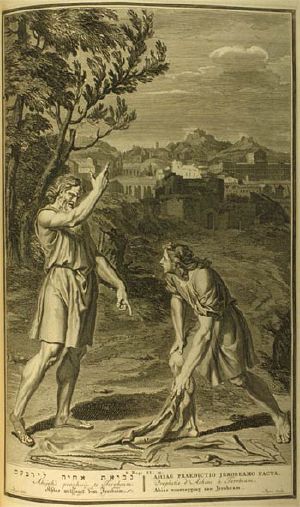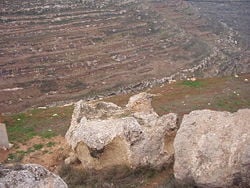Shiloh (Bible)
Shiloh (Hebrew: שלה - Šīlōh) was a city in the ancient Israel, situated north of Bethel and south of Shechem in the hill-country of Ephraim (Judg. 21:19). During the period of judges, it was a major religious center and the permanent cite of the sacred Tabernacle which the Israelites carried through the wilderness.
The Bible describes Shiloh an assembly place for the people of Israel from the time of Joshua. Sacrifices were brought there there by the Israelites during the period of judges, and it was also the site of various religious celebrations and festivals. The prophet Samuel was reportedly reportedly there, and the Ark of the Covenant remained at Shiloh until it was captured by the Philistines in the battle of Aphek during the time of the high priest Eli.
Shiloh declined in importance after the establishment of the Temple of Jerusalem. However, it became briefly famous as the home of the prophet Ahijah of Shiloh, who commissioned Jeroboam I to become the king of Israel in opposition to the Davidic dynasty.
A modern Israeli settlement has been established adjacent to Tel Shilo next to the Palestinian town Turmus Ayya. About 1200 people live in Shilo proper, with about another 700 people living within its municipal boundaries. The future of modern Shilo—whether it will become part of a future Palestinian state or be claimed as Israeli territory—is disputed.
Biblical Shiloh
At Shiloh, the "whole congregation of Israel assembled...and set up the tabernacle of the congregation" (Joshua 18:1). According to Talmudic sources, the Tabernacle rested at Shiloh for 369 years (Zevachim 118b), although modern scholars believe the period to have been considerably shorter.
At some point during its stay at Shiloh, the portable tent seems to have been enclosed within a compound or replaced with a standing structure with permanent doors (1 Samuel 3:15), a precursor to the Temple.
Though other important places of worship and government existed during this period, Shiloh was a major religious center. "The people," assembled here for feasts and sacrifices, and here lots were cast under Joshua's guidance for the various tribal areas (Joshua 18:10) and Levitical cities (Joshua 21).
The centrality of Shiloh's altar became bone of contention when the eastern tribes—Reuben, Gadites and Manasseh—built their own worship center near the Jordan River, nearly provoking an inter-tribal war until these tribes agreed that the altar would serve only as a monument and not rival place of sacrifice (Joshua 22:28).
Nevertheless, other sacrificial altars were clearly in evidence during the period, including at Mount Ebal (Joshua 8:30), Ophrah (Judges 6:24), Zorah (Judges 13:20) (Joshua Joshua 24:26), Bethel (Judges 21:4), Ramah (1 Samuel 7:17), Gilgal (1 Samuel 10:8) and others.
When a war between the tribe of Benjamin and other Israelite tribes left the Benjaminites without an adequate number of women, Shiloh's role as a religious center presented a bizarre solution. As part of the peace settlement, the leaders of the other tribes gave the Benjaminites permission kidnap wives for themselves from a religious celebration in Shiloh, as the young women came from Shiloh to dance in the vineyards (see Judges 21).
Later, the prophet Samuel was raised at the shrine at Shiloh by the high priest Eli. Meanwhile, Eli's sons Hophni and Phinehas had become corrupt, and another prophet predicted that God's blessing would be removed from Eli's lineage.
When the Philistines confronted the Israelites at Aphek, the Israelites brought forth the Ark of the Covenant from Shiloh as their standard. Although this act temporarily threw the Philistines into confusion, they were able to rally effectively, defeat the Israelites, and carry the Ark of the Covenant off to Philistia. The Ark was soon returned to Israel, but was subsequently kept in Kiryat-Yearim until David had it brought to Jerusalem. It never returned to Shiloh. Some believe that Shiloh itself may have been destroyed by the Philistines at this time, although this is not clear from the record.
During the reign of King Saul, Eli's descendants Ahimelech and Abiathar were to be found at an otherwise unknown religious center called Nob, where they gave aid to the fugitive David and were infamously attacked by agents of Saul, with only the young Abiathar surviving the slaughter.
Some of the Shilonite priests came to Jerusalem during the reign of King David, who brought the Ark of the Covenant to his new capital and established a central altar there. Abiathar, Eli's great-grandson, served as David's high priest together with Zadok until he made the mistake of backing Adonijah instead of Solomon as David's successor, for which he was banished by Solomon.
Other than Eli and Samuel, the most famous Shilonite was the prophet Ahijah. After Solomon had sinned by constructing altars to honor of the gods of his Moabite and Ammonite wives near Jerusalem, Ahijah commission Jeroboam I as the future king of Israel, leaving only the territory of Judah to David's descendants. When Solomon died, ten of the tribes seceded, and their religious leaders built local worship sites as alternative pilgrimage destinations to Jerusalem's temple. At this time, Shiloh may have been revived as a holy shrine. In any case it was home to Ahijah, who later turned against Jeroboam for creating the shrines at Dan and Bethel and predicted his line's demise (1 Kings 14:6-16)
Shiloh virtually disappears from the biblical record after this. However, in the early sixth century B.C.E., the prophet Jeremiah would refer to Shiloh's shrine as a place of desolation, predicting that God would to likewise to Jerusalem if its priests and people did not repent:
- Do not trust in deceptive words and say, "This is the temple of the Lord, the temple of the Lord, the temple of the Lord!" Will you steal and murder, commit adultery and perjury, burn incense to Baal and follow other gods you have not known, and then come and stand before me in this house, which bears my Name, and say, "We are safe"?... Go now to the place in Shiloh where I first made a dwelling for my Name, and see what I did to it because of the wickedness of my people Israel... What I did to Shiloh I will now do to the house that bears my Name, the temple you trust in, the place I gave to you and your fathers. (Jeremiah 7:4-14)
Nevertheless, Jeremiah also indicates that Shiloh remained prosperous enough that a few years later—along with the important northern cities of Shechem and Samaria—it could send delegates with expensive grain and incense offerings to the Jewish governor Gedaliah during the early period of Babylon rule (Jeremiah 41:5).
The Elohist and Shiloh
A number of biblical scholars who accepted the documentary hypothesis of biblical criticism believe that the "Elohist" ("E") source of the Pentateuch originated from Shiloh. E denigrates the priesthood of Aaron through such stories as the Golden Calf and Aaron's criticism of Moses' wife. The E version of the Ten Commandments is also though to condemn both gold calves of the rival northern priesthood at Bethel and the gold-plated cherubim of the Aaronid priesthood at Jerusale.
E never mentions the Temple of Jerusalem nor the Ark of the Covenant associated with the Aaronid priesthood. Some believe it may have been Shiloh which originally house the Nehustan, the bronze snake created by Moses in the wilderness, which was later moved to Jerusalem but was later destroyed by King Hezekiah as an object of idolatry.
Shiloh in Samaritan tradition
Later references
In the Common Era, Shiloh is occasionally mentioned as a pilgrimage site of Christians and Muslims. St. Jerome, in his letter to Paula and Eustochius, dated about 392-393, wrote: "With Christ at our side we shall pass through Shiloh and Bethel." However, the church of Jerusalem did not schedule an annual pilgrimage to Shiloh, unlike Bethel. The only pilgrim other than Jerome that mentions its name—the sixth-century pilgrim Theodosius—wrongly located it mid-way between Jerusalem and Emmaus. This and other mistaken identifications lasted for centuries.
Muslim pilgrims to Shiloh mention a mosque called es-Sekineh where the memory of Jacob's and Joseph's deeds was revered. The earliest source is el-Harawi, who visited the country in 1173 when it was occupied by the Crusaders, wrote: "Seilun (Shiloh) is the village of the mosque es-Sekineh where the stone of the Table is found. Later Muslim writers make similar mentions of the site.
Shiloh assumed messianic attachment among Christians due to the verse (Genesis 49:10): "The scepter shall not depart from Judah, nor a lawgiver from between his feet, until Shiloh comes, and unto him shall the gathering of the people be." Shiloh here is believed by some Christians to refer to Jesus as the Messiah.
Archaeology
The first archaeological excavations at Tel Shiloh began in the years 1922-1932 by a Danish expedition. The finds were placed in the Danish National Museum in Copenhagen. In 1980, Israel Finkelstein, an archeologist from Bar-Ilan University, initiated four seasons of digs and many finds were revealed including coins, storage jars, and other artifacts. Many are preserved at Bar-Ilan University. In 1981-1982, Zeev Yeivin and Rabbi Yoel Bin-Nun dug out from the bedrock area of the presumed site of the Tabernacle. Ceramics and Egyptian figurines were found.
These and other excavations have shown that the site of Shiloh was already settled as early as the nineteenth centuries B.C.E. (Middle Bronze Age IIA). However, it is not recognizably mentioned in any pre-biblical source. The site has yielded impressive remains from the Caananite and Israelite eras until the eighth century B.C.E. Excavations have also revealed remains from the Roman and Persian, as well as early and late Islamic periods. An impressive earthworks has been located and pottery, animal remains, weapons and other objects have been recovered.
During the summer of 2006, archaeological excavations were carried out adjacent to Shiloh’s tel. A team led by Israel's Civilian Administration Antiquities Unit discovered the mosaic floor of a large Byzantine church which was probably constructed between 380 and 420 C.E. The following year, a dig carried out just south of Tel Shiloh exposed elaborate mosaic floors as well as several Greek inscriptions, one explicitly referring to the site as the "village of Shiloh". A total of three Byzantine basilicas have now been uncovered.
Modern Shiloh
Shiloh resumed its status as a Jewish town in 1978 when a group of Jews affiliated with the Gush Emunim settlement movement established themselves at the location to the location to assert Jewish rights to the area. In 1979 the Israeli government officially authorized Shiloh's status as a recognized village. The population (2006) of the village is approximately 1500 and the community contains educational institutions, grocery, a yeshiva, sports fields, a pool, and several synagogues, one scale-modeled to the ancient Tabernacle. It is built on disputed territory, claimed by the Palestinian Authority as part of a potential independent state.
See also
- Eben-Ezer
- Song of Moses
External links
- Rabbi Ariel Bar Tzodeck's Insight into Shiloh (a Kabbalist perspective)
- Shiloh in the Jewish Encyclopedia
- photos of the Mosaic from Tel Shiloh
- photos of the Mosaic from Tel Shiloh "Church of the ark found in the west bank"
- Photos of Tel Shiloh
Credits
New World Encyclopedia writers and editors rewrote and completed the Wikipedia article in accordance with New World Encyclopedia standards. This article abides by terms of the Creative Commons CC-by-sa 3.0 License (CC-by-sa), which may be used and disseminated with proper attribution. Credit is due under the terms of this license that can reference both the New World Encyclopedia contributors and the selfless volunteer contributors of the Wikimedia Foundation. To cite this article click here for a list of acceptable citing formats.The history of earlier contributions by wikipedians is accessible to researchers here:
The history of this article since it was imported to New World Encyclopedia:
Note: Some restrictions may apply to use of individual images which are separately licensed.




